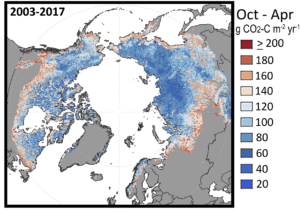
Permafrost is ground that has a temperature below freezing for at least two consecutive years.
Permafrost varies in thickness from less than a couple of feet to more than 4,000 feet thick. Permafrost is mostly located in polar regions, although it also occurs in some high mountains where it is called alpine permafrost. Much of the permafrost in Alaska is tens of thousands of years old.
Permafrost near the surface contains plant material that has not yet completely decomposed. During photosynthesis, plants pull carbon dioxide out of the atmosphere. When they die, or when they drop their leaves in fall, the plant material decomposes and returns the carbon dioxide into the atmosphere. In the Arctic, plants grow slowly and they also decompose slowly as plant material freezes and becomes part of the permafrost.
The carbon in the plant is stored in the permafrost, and after many centuries the result is that there is a lot of carbon stored in the permafrost. It is estimated that the amount of carbon frozen in the permafrost is more than two times the amount of carbon currently in our atmosphere.
The Arctic is warming faster than anywhere else on the planet, and its permafrost is starting to thaw. One-fifth of frozen soils in the Arctic are thawing rapidly, and that is a concern for enhancing the existing global warming. As the ground thaws, the microbial activity increases and the plant material currently frozen in the permafrost will decompose, adding carbon dioxide into the atmosphere. The thawing that is being observed will enhance global warming by adding carbon.
Some villages in the Arctic are built on permafrost. Permafrost is harder than concrete when frozen; however, the soil loosens as it thaws. Buildings, homes, roads and other infrastructure get damaged as the permafrost thaws and weakens.
Steve Ackerman and Jonathan Martin, professors in the UW-Madison department of atmospheric and oceanic sciences, are guests on WHA radio (970 AM) at 11:45 a.m. the last Monday of each month. Send them your questions at stevea@ssec.wisc.edu or jemarti1@wisc.edu.

